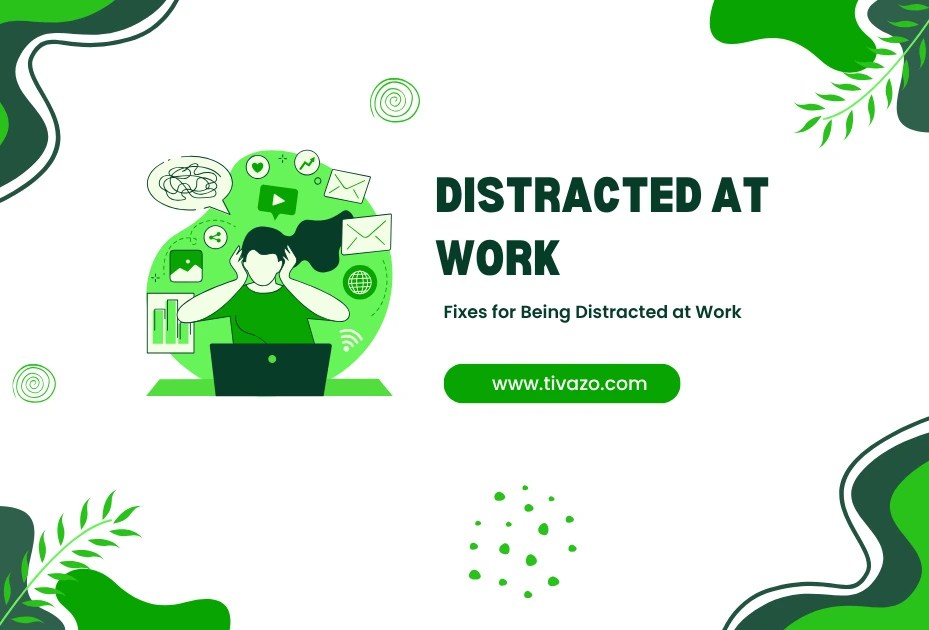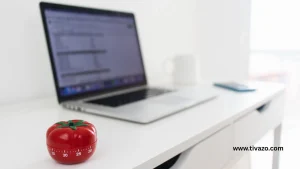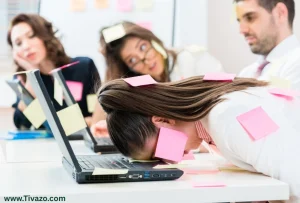Picture this: you’re at your desk, fully planning to work through your to-do list. Ten minutes in, you check your phone. You get a ping from a Slack message. Then, a colleague walks by asking for a “quick question.” An hour goes by before you know it, and you haven’t made a dent in your high-priority task.
Does this scenario resonate at all? If your answer is yes, you’re not alone. In our hyper-connected world, being distracted at work is more the norm than it is the exception. A study found that it takes an average of 23 minutes and 15 seconds to regain full focus after an interruption. That is a major drain on productivity.
So why do so many individuals find it tremendously challenging to maintain mental focus at work, especially when they have the best of intentions to get work done? In this blog, we will explore the psychological, digital, and environmental reasons for being distracted at work and, more importantly, provide 8 meaningful solutions that you can implement to change your workday for the better.
Key Highlights:
- How Being Distracted at Work Affects Your Performance
- 8 Fixes to Stop Getting Distracted at Work
- Comparing Good vs. Bad Employee Qualities: What Makes the Difference?
- How Leaders and Teams Contribute to Workplace Distractions
- Creating a Personal Focus Ritual That Works for You
What Causes You to Be So Distracted at Work?
To combat being distracted at work effectively, it is important to understand how distraction first occurs. The distractions we face daily can come in many forms, such as digital clutter (emails, instant messages, notifications from apps, etc.) that commandeer your mind, keeping you from completing your work.
The concept of cognitive overload occurs when you are attempting to multitask or cannot remember the different tasks, coping with responsibilities, multitasking creates mental overstimulation and limits your cognitive abilities; this overload reduces your capacity to concentrate/focus. Mental fatigue created from negative emotional states (e.g., stress, increased burnout, taking on so much more with little reward or lack of interest) slowly consumes your mental energy, pushing you to be easily distracted at work.
Those with ADHD sensory issues may struggle with distractions even more notably if working in an open-plan office or home environment.
How Being Distracted at Work Affects Your Performance
The effects of being distracted at work extend far beyond simply missing a deadline. Your focus being compromised makes it impossible for your brain to operate optimally. When attention is compromised, cognitive performance decreases, and the clarity of your thinking, reasoning, and problem-solving becomes less effective. This usually equates to productivity loss (at best), at worst, you become ineffective, and the quality of your work also decreases.
With each distraction, the chances of making errors increase, and this can again lead to significant consequences depending on the nature of the work you are doing.
Distraction can affect more than just the quality of your work. The impact of being distracted at work also leads to significantly lower job satisfaction and overall well-being. If you want to improve your productivity at work, regaining and maintaining your focus cannot just be seen as beneficial – it is essential to your success all day long.
8 Fixes to Stop Getting Distracted at Work

Fix 1: Align Tasks With Your Circadian Rhythm
We have a biological clock in our bodies, our daily circadian rhythm, that can dictate when we feel awake enough to be productive and work with focus. Research has shown that we will have twice the number of mental performance peaks during the day, 9 am to 11 am (when we wake up), and 2 pm to 4 pm.
You can use those performance peaks to leverage your natural boost in energy and use your peak times for your most difficult, mentally demanding tasks. During those times, you have your productive time blocks, use your phone (or notifications) to minimize being distracted at work, and target hours that would be methodically distraction-free.
Fix 2: Use Cognitive Behavioral Techniques to Rewire Distraction Loops
Use Cognitive Behavioral Techniques to Rewire Distraction Loops. Cognitive Behavioral Therapy (CBT) is not only for those with anxiety; it can be a way to scientifically re-train our brains to better manage distractions. One effective way to harness the power of CBT is through journaling.
Some people have used the journal to track when distractions occur and which distractions and why, without thinking, only to be aware of patterns later. Then, simply through thought replacement, we could eventually replace some of the temptations we recognize as some form of distracting and compulsive, i.e., instead of thinking “I will just look at my phone for a minute”, tell yourself “that will break my flow”.
Think about several small goals of maybe 15 minutes of continuous work and a reward to reinforce the cognitive behavior approach towards being distracted at work.
Fix 3: Build a Distraction-Free Work Routine
Developing a routine can help reduce decision fatigue and protect your ability to focus. Begin your mornings with a solid morning routine that will prepare you mentally for the day. Incorporate techniques such as those in Eat That Frog by doing the hardest task as the first thing when your energy is at its peak.
To reduce being distracted at work, purchase noise-canceling headphones or use brown noise apps that lessen distracting sounds. By creating your environment and routines intentionally, you establish a distraction-free work system that reduces distractions at work and supports a continual flow.
Fix 4: Gamify Your Focus With Rewards & Challenges
Humans are naturally motivated by achievement and competition, so turning your work into a game can boost engagement and focus. Apps like Forest and Habitica gamify productivity by using levels or quests to turn tasks into fun and game-like experiences that you want to continue.
After every focused work session, such as after Pomodoro intervals, you can reward yourself with a treat or a break! If you like working with others for social motivation, try “Focus Sprints” with your coworkers.
This adds a little competition to drive others to their focused productivity. You are playing, and thus you’re more productive at work, and it’s one of the best apps for staying focused at work.
Fix 5: Apply the Pomodoro Technique With a Twist
The classic Pomodoro Technique of 25 minutes work, 5-minute break works well for many people, but customizing it can be more catered to your attention span. One example is using “Focus Blocks,” which can be 50 minutes of uninterrupted work, followed by a 10-minute break. You can stack two Focus Blocks before taking a break for longer than 10 minutes. This respects your natural energy cycles and supports moving to deeper focuses.
You’ll find many apps, such as Session or Tide, that will automate those Focus Blocks, which will encourage you to stick with the rhythm.
You can also customize your Focus Blocks for precisely those tuned intervals to help you identify new ways to stop losing focus at work and learn how to build focus at work..
Fix 6: Practice Mindfulness Techniques to Stay Focused at Work
Mindfulness trains your mind to notice drifting thoughts and to gently return attention to the present moment. Routine physical exercises, even as simple as box breathing: inhale, hold, exhale, hold, all for a count of four, can calm the nervous system and increase concentration.
Practice short one-minute mindfulness check-ins every hour to re-energize your mental focus without breaking your workflow. Various apps like Headspace or Insight Timer provide guided mindfulness practice to enhance your skill in the long term. Practicing these habits creates greater mental focus at work and deepens other techniques for being present.
Fix 7: Customize Your Environment Based on Your Focus Personality
Knowing your “concentration personality” can be a helpful guide in designing a workspace that fits your focus style. And if you’re a “Monk” who is all about silence, play ambient sound playlists or wear noise-canceling headphones to reduce noise and distractions. If you’re a “Bee” who prefers a little background buzz, try out some curated playlists or low-level chatter.
Cutting through the visual noise happens by clearing workspace clutter per the 5-item rule (leave only 5 things on your desk that you can’t live without). Control lighting and smells — peppermint, for example, is thought to make you more alert — to manipulate the environment so that it’s catered to you, so you can accommodate for office distractions and concentrate with noise.
Fix 8: Plan Weekly Deep Work Rituals to Improve Concentration at Work
Carving out special “deep work” sessions each week that are removed from meetings, email, and even interruptions can have a transformative impact on your ability to focus. Be strategic about when you block out periods. Ideally, you’ll do this when you naturally have higher energy and focus, and signal to colleagues that you are in “Deep Work Mode” to avoid unnecessary interruptions.
After every session, think of which methods are effective and which can be improved, enabling improvement of your working habits. Not only does this get you focusing at work better, but it also ingrains a regular how for staying focused at work.
These techniques help us from being distracted at work
Why Multitasking is a Myth When It Comes to Focus
It may seem like multitasking, such as replying to emails while simultaneously working on reports, can help productivity, but research shows that this is a myth. Multitaskers always perform worse than non-multitaskers on surveys of memory and attention. According to a Stanford University study, multitasking leads to an overload that hinders performance.
Efficient versus multitasking. Rather than spreading your attention overall, it’s much more efficient to handle one thing at a time with deep focus.
This method is designed to minimize cognitive load and increase mental focus at work – a simple, effective way to avoid losing focus at work and improve performance in general.
Comparing Good vs. Bad Employee Qualities: What Makes the Difference?

How Leaders and Teams Contribute to Workplace Distractions
Workplace distractions often come from a combination of habits of others, team dynamics, and leadership approaches. For example, unclear communication and leadership bandwidth overload are leading contributors to distractions (Forbes). When your employees do not have direction on what their priorities and expectations are, they waste time shifting their focus from task to task and fragmenting their focus, reducing productivity.
Leaders model the tone when they practice a culture oriented towards deep work. Simply put, they can create an environment that maximizes work activities without distractions.
Leaders should schedule a consistent and purposeful meeting, e.g., a weekly review, to communicate team priorities, goals, and/or milestones.
Creating a Personal Focus Ritual That Works
Design a personal ritual to get your mind ready for focused work:

3P Method:
- Prepare: Clear clutter from the workspace.
- Protect: Put digital noise on hold.
- Perform: Set a timer, breathe, and go.
Keywords: how to increase work focus, how to create a productive work ritual without being distracted at work.
Conclusion: From Scattered to Sharpened – Your Focus Reclaimed
Getting distracted at work is not a personal weakness; it’s a natural product of an environment designed to divide your attention. But with the proper tactics, you can restore focus, one deep breath, and one job at a time.
Choose a fix. Implement it today. Share your experience. And remember—focus is a skill, not a characteristic.
FAQs
Do I have ADHD or am I just easily distracted?
Occasional distraction is normal. If you consistently struggle with focus, impulsivity, and organization across multiple areas of life, consider speaking with a mental health professional.
Why can’t I focus at work?
Lack of focus can stem from digital overload, poor sleep, stress, or unclear priorities. Structuring your day and minimizing multitasking can help.
How do I stop being distracted?
Use tools like focus apps, create a distraction-free workspace, and set clear daily goals. Mindfulness and task batching also work wonders.




